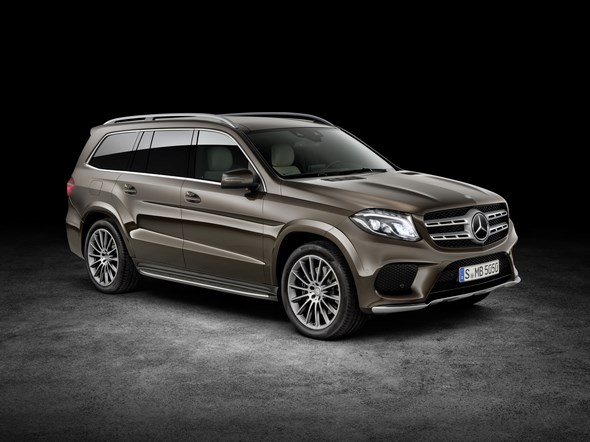The tenth all-wheel drive model series from the pioneer
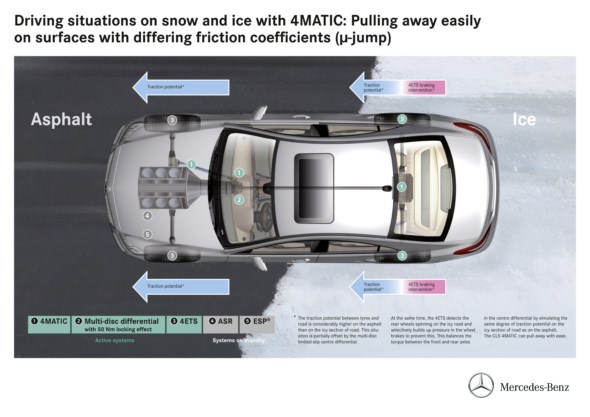

4MATIC permanent all-wheel drive for the CLS for the first time
Stuttgart/Hochgurgl – For years now, Mercedes-Benz has been successful as a 4×4 manufacturer in the premium segment. Production has soared since the launch of the M-Class in 1997. Today, Mercedes-Benz offers nearly 50 models with 4MATIC across ten model series.
One of the fundamental factors in its success is the formidable performance of the 4MATIC drive concept on snow-covered or icy roads, with its high traction reserves, excellent directional stability, peerless safety and exceptional comfort levels.
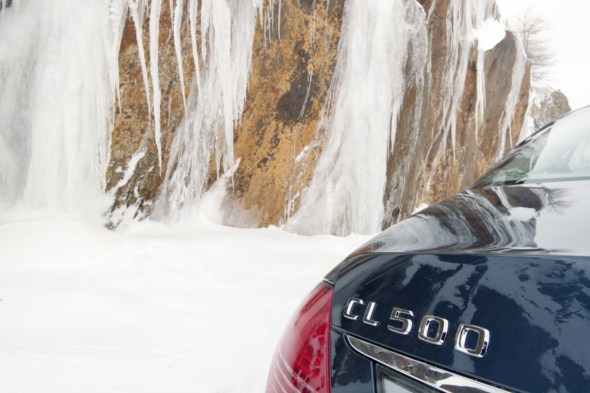
The new CLS is capitalising on these benefits too. For the first time, the four-door coupé is available with all-wheel drive in the guise of the CLS 350 CDI 4MATIC BlueEFFICIENCY and CLS 500 4MATIC BlueEFFICIENCY. Besides the CLS, the 4MATIC Workshop being staged in extreme winter conditions on the Timmelsjoch high alpine road in Austria also features the current versions of the S-, CL- and R-Class.
As with the 4MATIC system’s set-up on a dry or wet road, directional stability and, therefore, active safety are paramount at all times when wintry conditions prevail, too. The mechanical principle of the 4MATIC system featuring a 45:55 torque split between the front and rear axles and the multi-disc limited-slip centre differential with a basic locking torque of 50 Nm offer all the right ingredients.
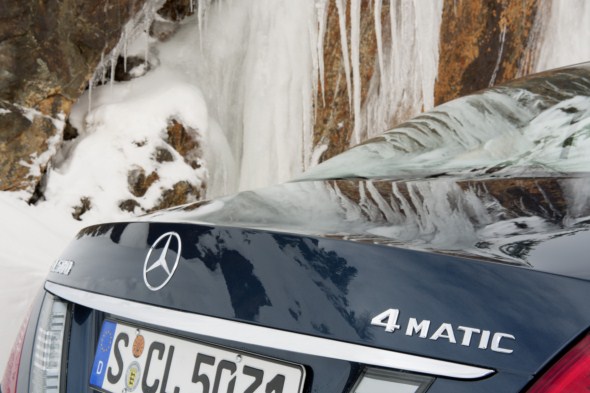
This basic design enables high levels of traction, as the dynamic shift in axle load toward the rear axle that occurs during acceleration is harnessed to deliver more drive torque to the rear wheels. However, the multi-disc differential lock is also able to shift the drive torque between the front and rear axles, varying the split as the road conditions dictate.
Consequently, intervention by the ESP®, 4ETS or ASR electronic control systems can be delayed for as long as possible and the bulk of the drive torque converted into tractive power, even on slippery roads.
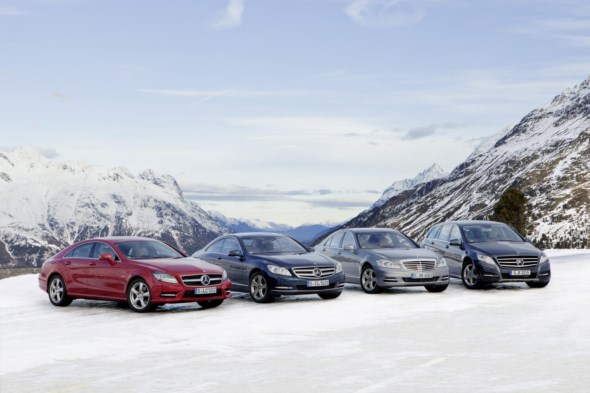
All control system interventions go virtually unnoticed, yet drivers still know straight away if they are driving on the limit: in such instances, a yellow warning symbol flashes in the instrument cluster as a highly visible prompt to adapt their driving style to the road conditions.
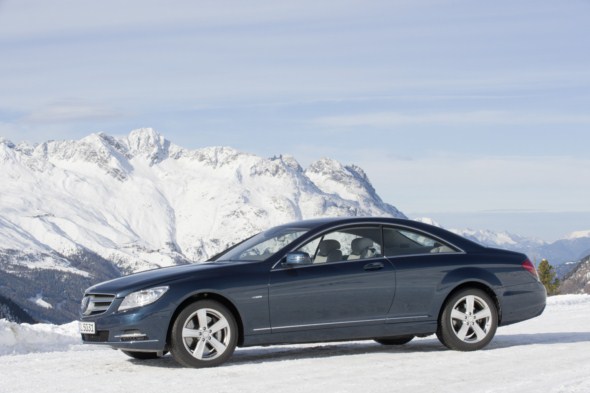
The drive mechanism’s permanently engaged design offers key advantages over other systems that first need to diagnose a lack of grip before activating the all-wheel drive. The 4MATIC system on Mercedes-Benz models will have already made use of this valuable time to start transmitting drive torque via the wheels to the road.
4MATIC: stable handling on snow and ice
When pulling away in wintry conditions, the 4MATIC models are designed to develop maximum traction. To this end, certain road conditions are automatically detected and the interventions of the 4ETS electronic traction control system adjusted so as to achieve the greatest possible acceleration while minimising wheel slip, ensuring optimum directional stability in the process.
This strategy also allows the vehicle to pull away under the most adverse conditions, such as when one side of the vehicle is on an icy slope (µ-split) or both wheels on either the front or rear axle have limited grip (µ-jump).

On twisting roads covered with snow and ice, vehicle stability is primarily controlled by the ASR acceleration skid control system’s regulation of engine torque. The ASR control thresholds are adjusted according to the driving situation based on the vehicle’s longitudinal and lateral dynamic readings as continuously measured by the ESP® sensor system.

If vehicle stability is to be maintained, the longitudinal force when cornering must be controlled by means of engine torque regulation in such a way that there are sufficient reserves of lateral force at all times. In order to comply with this physical correlation, when cornering on road surfaces with a low friction coefficient the control thresholds for engine torque regulation at the wheels on the outside of the bend are reduced considerably so that the tyres can develop sufficient lateral force.
4MATIC: cutting-edge technology breaks new ground
The 4MATIC powertrain fitted in Mercedes-Benz passenger cars is one of the best-performing permanent all-wheel drive systems on the market. The basic design concept, with the engine installed longitudinally and the integral transmission and transfer case unit, produces a compact, lightweight arrangement that minimises frictional losses, heralding a number of benefits compared to other passenger car systems with a transverse power unit and selectable 4×4.
Depending on the particular model, fuel consumption, for instance, is a mere 0.2 to 0.6 litres more per hundred kilometres than on an equivalent vehicle with conventional drive, while vibration and acoustic comfort meet the high standards expected of Mercedes-Benz vehicles.
CLS 4MATIC: stylish sportiness and dynamism in the winter too
Mercedes-Benz achieves the standard of driving dynamics which the CLS is renowned for courtesy of the highly sophisticated DIRECT CONTROL suspension with adaptive shock absorbers. The weight-optimised DIRECT CONTROL system, featuring a three-link front suspension and multi-link independent rear suspension, automatically adapts to the changing driving situation by varying the damping forces, resulting in a substantial improvement in ride comfort.
The air suspension system – optional for the CLS 350 CDI 4MATIC BlueEFFICIENCY and standard on the CLS 500 4MATIC BlueEFFICIENCY – is combined with a continuously variable, electronically controlled damping system that processes a series of sensor signals and controls each wheel individually. So, not only do Mercedes customers experience the best in comfort, they reap the benefits of excellent handling safety and sporty agility too.
A snug interior with a clear view: THERMOTRONIC climate comfort
Carefully balanced control of the interior climate is especially important in the winter. This is why Mercedes-Benz offers the THERMOTRONIC luxury automatic climate control system. Apart from regulating the climate separately for the driver, front passenger and passengers in the rear, it allows individual pre-settings to be programmed too.
This system furthermore includes a pollutant sensor which automatically switches to air recirculation mode if it detects any sudden increase in the carbon monoxide or nitrogen oxide levels in the outside air – when driving through a tunnel, for instance. Another highlight of the THERMOTRONIC system is the residual heat function: pressing the “Rest” button heats or ventilates the passenger compartment for around 30 minutes when the engine is switched off.
THERMOTRONIC heats up the passenger compartment extremely efficiently, even after a cold start on winter mornings. This is thanks to a heating output of eleven kilowatts, equivalent to the capacity of the central heating system in a modern family home. On the diesel models, a heat exchanger with six integral PTC heating elements (PTC = Positive Temperature Coefficient) is also activated when the outside temperature falls below a certain level in order to boost the effect of the main heat exchanger with an electrical output of around 1200 watts.
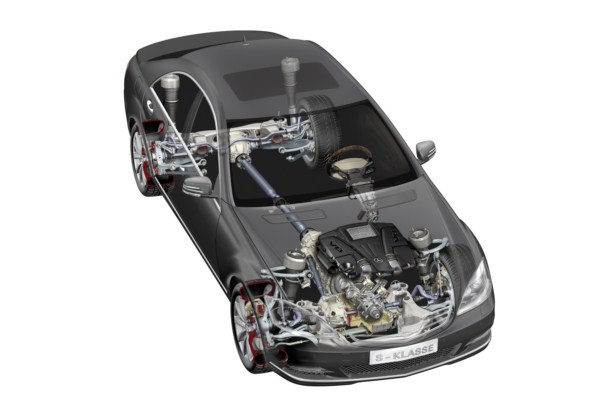
The assistance from the PTC heater is necessary due to the high thermal efficiency of today’s CDI engines, which is precisely what makes them so economical and means that they dissipate considerably less heat to the coolant under partial load conditions than conventional engines.
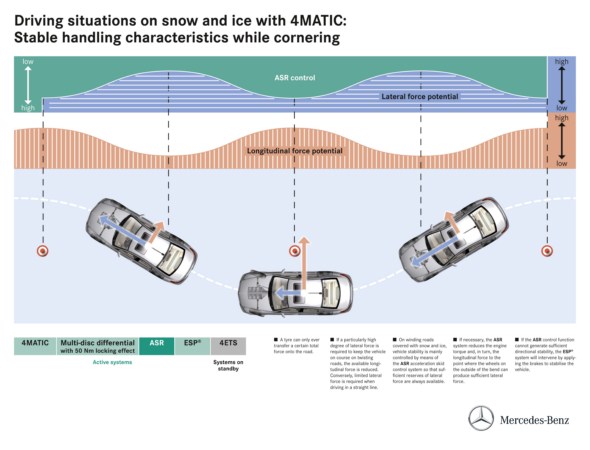
Mercedes offers 4MATIC in 48 passenger car models
The Mercedes-Benz all-wheel drive line-up currently encompasses 48 passenger car models across ten model series and offers an impressively wide choice: besides the E-Class and the C-Class, which both come in saloon and estate variants, the 4MATIC portfolio is enriched by models from the S-Class, CL luxury coupé, CLS four-door coupé and R-Class touring SUV ranges too.
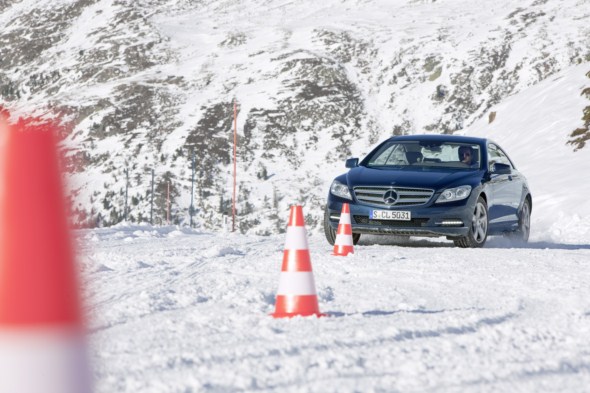
There is also the compact GLK as well as the GL-Class and M-Class off-roaders. Still going strong after 30 years in production, the G-Class truly comes into its own off the beaten track and continues to rank as one of the best cross-country vehicles in the world.
All-wheel drive development expertise since 1903
There is a reason why Mercedes engineers are so skilled in the development of groundbreaking all-wheel drive concepts. The history of all-wheel drive at Mercedes-Benz dates all the way back to 1903. Since then, the accepted maxim has been that all-wheel drive is the best technology for making quicker and safer progress under the most adverse conditions. Over the course of the years it has been successfully employed in a variety of Mercedes-Benz models.
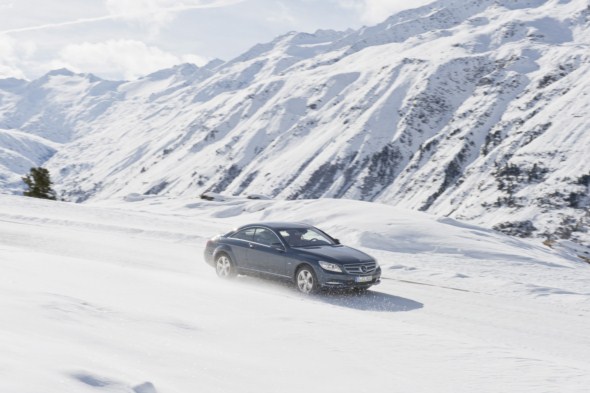
Some models, such as the G-Class and the Unimog, have attained legendary status all over the world. But all-wheel drive has its benefits in everyday operation on asphalt roads too, as demonstrated by the 4MATIC saloons from Mercedes-Benz. The innovative drive concept received its saloon premiere in the W 124 E-Class model series back in 1987.
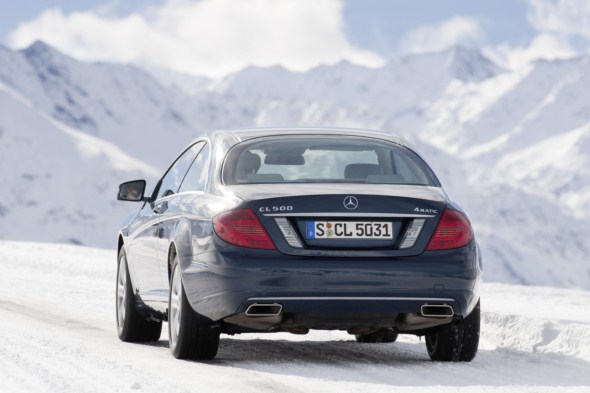
The 4ETS system made its debut aboard the M-Class in 1997.
Mercedes-Benz has therefore amassed a wealth of experience with these electronic control systems – more in fact than any other car manufacturer.
The automatic drive for wintry road conditions
Sure, predictable handling, plus impressive driving dynamics
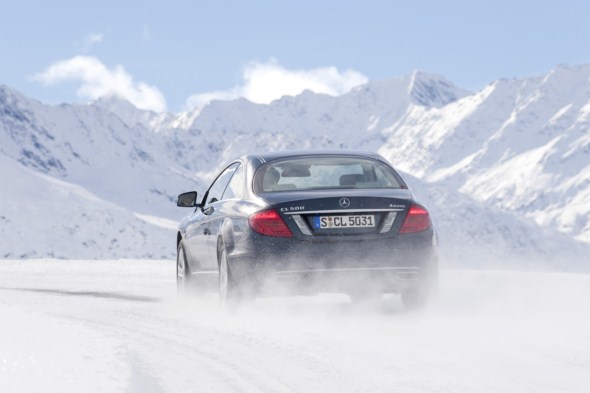
As with the 4MATIC system’s set-up on a dry or wet road, the directional stability and, therefore, the active safety of the 4MATIC models are paramount at all times when wintry conditions prevail, too. The mechanical principle of the 4MATIC system featuring a 45:55 torque split between the front and rear axles and the multi-disc limited-slip centre differential with a basic locking torque of 50 Newton metres offer all the right ingredients.
This basic design enables high levels of traction, firstly because the dynamic shift in axle load toward the rear axle that occurs during acceleration is harnessed to deliver more drive torque to the rear wheels. Secondly, the multi-disc differential lock is also able to shift the drive torque between the front and rear axles, varying the split as the road conditions dictate.
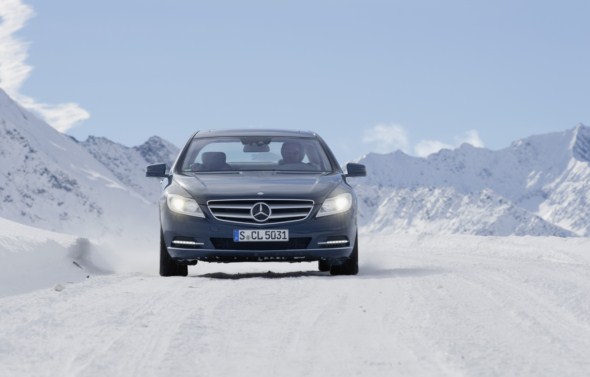
Consequently, intervention by the ESP®, 4ETS or ASR electronic control systems can be delayed for as long as possible and the bulk of the drive torque converted into tractive power, even on slippery roads. All control system interventions go virtually unnoticed, yet drivers still know straight away if they are driving on the limit, as a yellow warning symbol will flash in the instrument cluster. This serves as a prompt to adapt the driving style to the road conditions.

The drive mechanism’s permanently engaged design offers key advantages over other systems that first need to diagnose a lack of grip before activating the all-wheel drive. The 4MATIC will have already made use of this valuable time to start transmitting drive torque via the wheels to the road.
All-wheel drive is not a substitute for winter tyres
Like any other all-wheel drive system, the 4MATIC has to abide by the laws of driving physics. The fundamental rule is that a tyre is only able to transfer a certain level of overall force to the road surface. If a particularly high degree of longitudinal force is required during acceleration or braking, for example, the available lateral force is reduced.
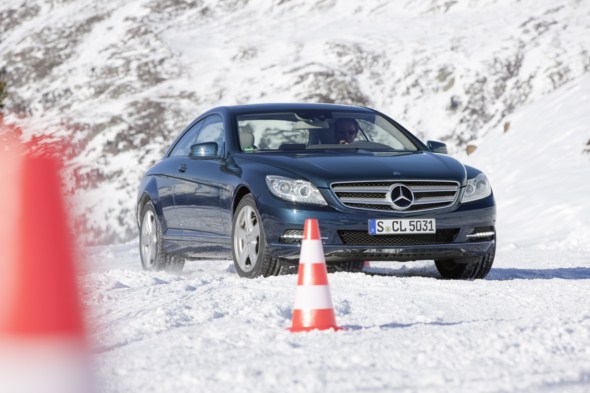
When cornering, the reverse applies: now a large amount of lateral force is required to keep the vehicle on course, while the longitudinal force potential is restricted. The engineers’ skill in designing the drive mechanism and fine-tuning the control systems lies in their ability to exploit these correlations in such a way as to ensure the best possible handling characteristics under all conditions. The frictional coefficient µ describes the physical grip between the tyres and the ground. This figure is high on a dry road (µ = 0.9) and low on a snow-covered road (µ = 0.3).

Despite all the engineers’ efforts, it is ultimately the drivers themselves who determine how safe they are out on the road. They should always adapt their driving style in accordance with the wintry conditions and ensure that their vehicle is suitably equipped; winter tyres are absolutely essential here.
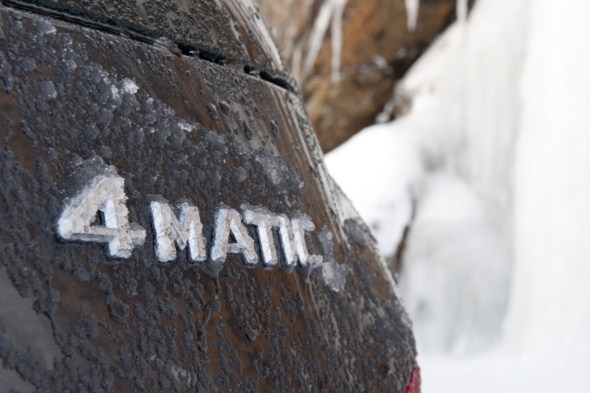
Pulling away with ease on ice and snow
When starting off in wintry conditions, certain road surface conditions are automatically detected and the interventions of the 4ETS electronic traction control system adjusted so as to achieve the greatest possible acceleration while minimising wheel slip, ensuring optimum directional stability in the process. This strategy also allows the vehicle to pull away under the most adverse conditions, such as when one side of the vehicle is on an icy slope (µ-split) or both wheels on either the front or rear axle have limited grip (µ-jump).
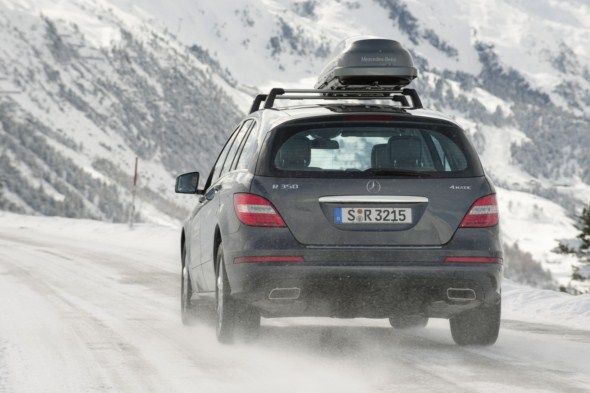
When starting off on µ-split, one side of the vehicle is on snow or ice and the other on asphalt. This means there are major differences in the coefficient of friction between the left and right-hand side of the vehicle. On all vehicles with open axle differentials, the wheel with the smallest friction coefficient limits the maximum transferable drive power. If the drive power exceeds the maximum transferable power, the wheels on snow or ice will start to spin and the vehicle would be unable to start off.
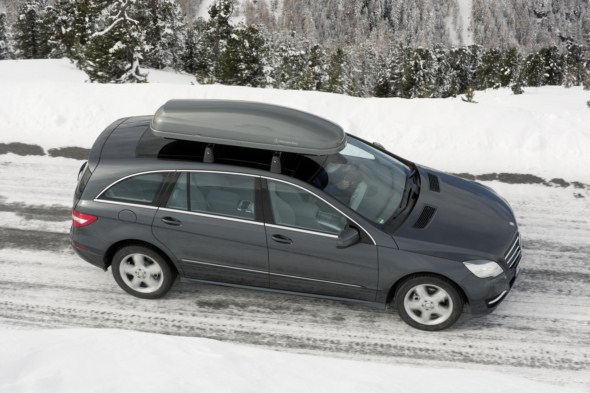
4ETS instantly detects this situation and prevents the wheels from spinning by building up exactly the right amount of pressure in the wheel brakes. As the wheel with the higher friction coefficient is now braced by the brake force at the wheel with the smaller friction coefficient, the 4MATIC model starts to move.

After pulling away, the wheel characteristics are closely observed and the brake pressure regulated in such a way that, as far as possible, there is no difference in speed between the individual wheels. The braking force applied by 4ETS effectively simulates a higher coefficient of friction on the side of the road covered with ice or snow; ideally, this will match the coefficient of friction on the asphalt side. This produces an optimal inter-wheel locking effect at the axle differentials, resulting in the maximum possible acceleration on µ-split surfaces.
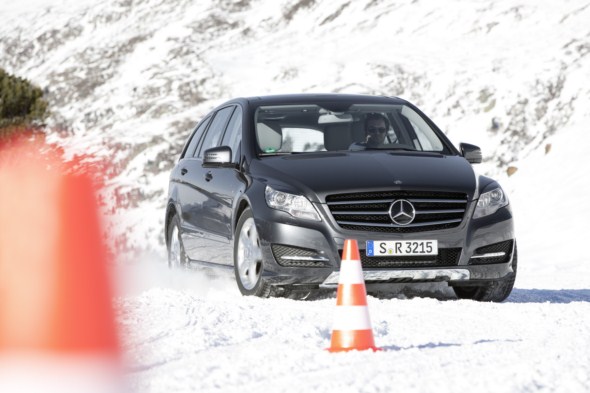
Starting off on “µ-jump” surfaces – where one of the vehicle’s axles is entirely on ice or snow and the other on asphalt – is hampered by the large differences in friction coefficient between the front and rear wheels. On vehicles with an open inter-axle differential, the axle with the lower coefficient of friction determines the transferable drive power. Whilst the multi-disc differential lock with its basic locking torque of 50 Newton metres does have a balancing effect, it is unable to compensate for these extreme differences in friction coefficient.
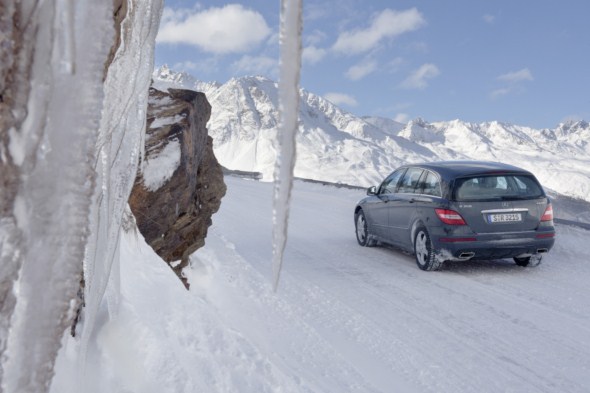
Here again, both wheels on the axle with the lower coefficient of friction start to spin if the drive power exceeds the maximum transferable drive power at this friction coefficient. The 4ETS resolves this problem by instantly detecting spinning wheels and braking them. In this way, the braked axle with the smaller friction coefficient braces the axle with the higher friction coefficient – and the 4MATIC model starts to move.
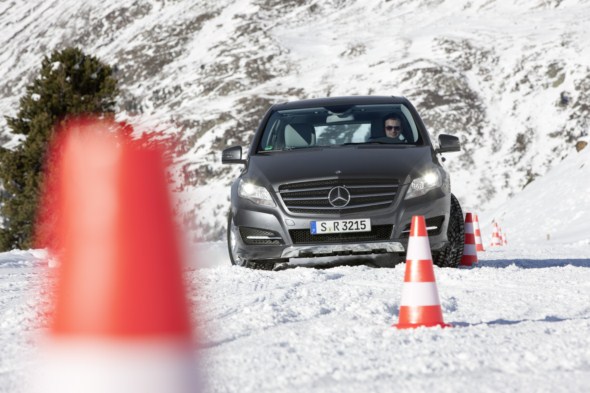
Assured handling on wintry roads
On twisting roads covered with snow and ice, vehicle stability is primarily controlled by the 4ETS system’s acceleration skid control function regulating engine torque. The 4ETS control thresholds are adjusted according to the driving situation based on the vehicle’s longitudinal and lateral dynamic readings as continuously measured by the ESP® sensor system.
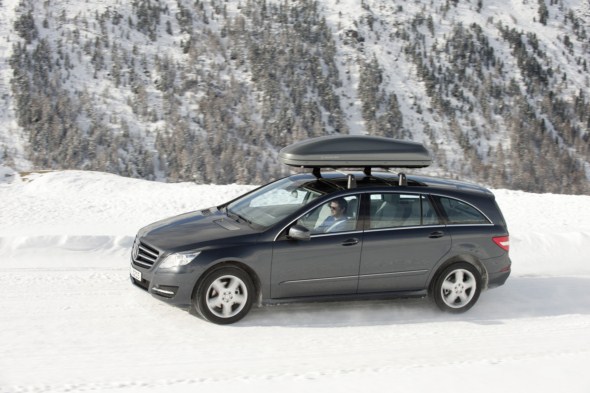
To prevent the vehicle from tail-skidding, the longitudinal force when cornering must be controlled by means of engine torque regulation in such a way that there are sufficient reserves of lateral force at all times. In order to comply with this physical correlation, when cornering on road surfaces with a low friction coefficient vehicle stability is mainly controlled by the ESP® and ASR acceleration skid control systems intervening to ensure that there is always sufficient lateral force in reserve.
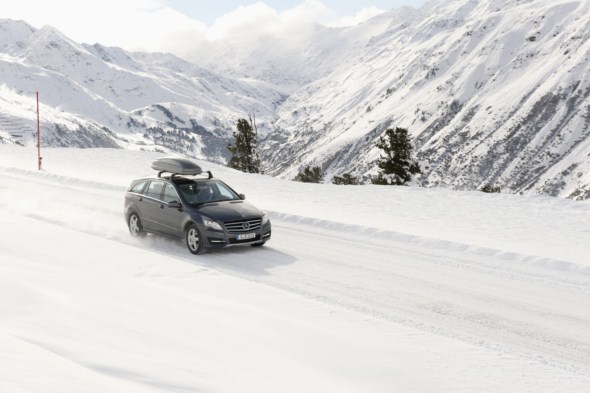
Initially, only enough engine torque to allow the tyres to develop sufficient lateral force is transmitted to the wheels on the outside of the bend. If the ASR control function cannot restore directional stability, the ESP® system will intervene by applying the brakes to stabilise the vehicle.

In contrast to the control mechanisms triggered when cornering, considerably more longitudinal force can be provided when accelerating in a straight line, as the tyres hardly have to transfer any lateral force. What is important here is that the tyres can work in the optimum µ-slip curve range.

In order to achieve this, the control thresholds for engine torque regulation are raised in this driving situation. When driving on snow-covered or icy roads with low friction coefficients, the multi-disc differential lock in the transfer case takes effect, producing an inter-axle locking torque of 50 Newton metres in the powertrain.

This locking effect boosts traction considerably without having any negative impact on the control systems. When the final-drive ratios are factored in, this allows 150 Newton metres to be delivered to the wheels.

In certain wintry conditions it may become necessary to deactivate the control systems using the “ESP® OFF” switch. This is the case where high slip values are required at the wheels – when powering out of deep snow, for instance, either with or without snow chains. Even in “ESP OFF” mode, drivers can still count on the full support of the control systems when braking.

Once back on a road surface with a normal covering of snow, the control systems should be reactivated again.
The current 4MATIC generation
Lighter, more compact, more efficient

Compared to the previous all-wheel drive technology, the latest generation of the 4MATIC all-wheel drive system stands out for its higher efficiency, lower weight and more compact design. These advantages over the predecessor models translate into superior traction and greater fuel economy.

Depending on the particular model, this means that fuel consumption is a mere 0.2 to 0.6 litres or so more per hundred kilometres than on an equivalent vehicle with conventional drive.
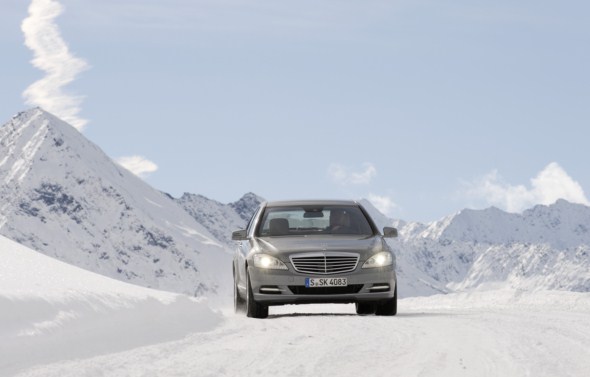
The latest-generation 4MATIC only adds 50 to 70 kilograms of extra weight (depending on model) and boasts a compact design that now takes up less space. As a result, no modifications to the bodyshell are required and it does not encroach on the front-passenger footwell. What’s more, the compact design helps to improve noise and vibration levels.

Transfer case integrated in 7G-TRONIC automatic transmission
The 4MATIC transfer case, featuring a planetary centre differential and a pair of bevel gears acting as a lateral output to the front axle, is integrated into the 7G-TRONIC PUS automatic transmission that always comes as standard on the 4MATIC models. The centre differential produces the 45:55 torque split between the front and rear axles that has the aforementioned positive impact on handling stability and traction.
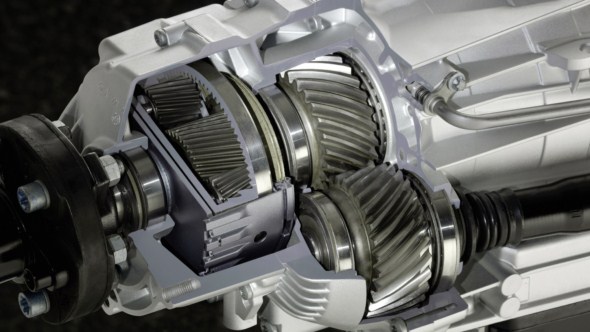
Further highlights of the powertrain include the lateral output to the front axle as well as the rear universal joint that is integrated into the power take-off’s output gear. This space-optimised design enables the front axle propshaft to be run very close to the transmission without having to modify the bodyshell in any way.
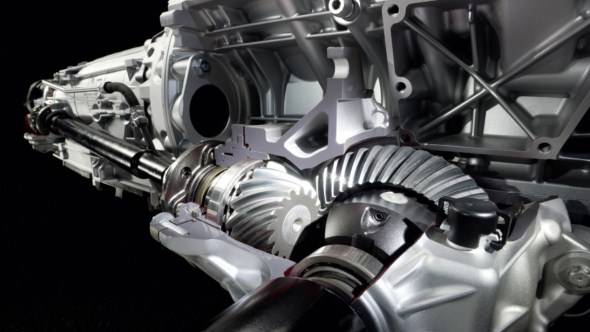
The higher efficiency of the 4MATIC drive system compared to the predecessor models is largely down to the omission of the gear stage for the transfer case’s power take-off as well as an improved oil supply, since the integral design means that transmission and transfer case share the same oil circuit. This sophisticated 4MATIC technology together with the weight saving result in a substantial reduction in fuel consumption.
ADAPTIVE BRAKE: state-of-the-art brake control system ensures shortest stopping distances – even in wintry road conditions
The ADAPTIVE BRAKE control system incorporates the basic anti-lock braking system (ABS), acceleration skid control (ASR) and yaw control functions. ABS and ASR record and control the driving dynamics along the vehicle’s longitudinal axis, while the yaw control looks after the lateral dynamics. If ADAPTIVE BRAKE diagnoses critical driving situations, corrective braking and control of drive torque are used to maintain or restore traction and directional stability as far
as is physically possible.
New additional braking functions make the ADAPTIVE BRAKE system even safer and more convenient. Hill-Start Assist prevents the vehicle from rolling in the opposite direction to that intended by the driver. The set of functions also
includes brake priming: should the driver suddenly release the accelerator, the system prepares for possible panic braking by pressing the brake pads lightly against the brake discs. If the brakes are indeed applied with full force, the
instantaneous build-up of pressure when the brake pedal is pressed shortens the stopping distance by a significant amount. Thanks to ADAPTIVE BRAKE’s ability to produce even the smallest brake pressures with great precision, it is possible to remove the film of water which forms on the brake discs in wet conditions by gently applying the brakes for a brief time. This shortens the brakes’ response time when driving in the wet, thus reducing the stopping distance even further. This function is triggered automatically once a certain number of windscreen wiper cycles has been reached and the driver has not applied the brakes in the meantime.
Four bestsellers involved in winter test
Exceptional traction combined with varying characters
Two coupés, one luxury saloon and a family SUV: the full spectrum of Mercedes-Benz 4MATIC models can be experienced on the test drives in Hochgurgl.
The second-generation CLS: also available with 4MATIC
With the arrival of the CLS in 2003, Mercedes-Benz created a brand new vehicle category which for the first time combined the elegance and dynamism of a coupé with the comfort and functionality of a saloon. The new CLS builds on the pioneering role of its predecessor yet at the same time is an entirely new edition – one that boasts 4MATIC all-wheel drive too. The eye is immediately caught by the innovative front design, which is reminiscent of the Mercedes-Benz SLS AMG. The characteristic CLS outline, with its elegantly elongated proportions, forms another dominating attribute. The interplay between lines and surfaces has been fashioned anew to enhance the effect of the dynamic, athletic form. The front structural ridge above the wing slopes down at the rear.
Referred to by the designers as the “dropping line”, this design feature is also a reinterpretation of a styling hallmark that echoes back to the matchless wealth of forms present in the great Mercedes sports cars of the past. A bold and muscular sports-car-like shoulder line above the rear axle highlights the athletic character of the new CLS.
The CLS is furthermore the first car in the world to offer the option of LED High Performance headlamps, which combine the fascinating colour effect of LED technology – resembling daylight – with the performance, functionality and energy efficiency of today’s bi-xenon generation. This new system offers the same Intelligent Light System that has already proven itself in Mercedes models with bi-xenon headlamps, but combined with LED technology for the first time.
The ultimate in efficiency: this is the hallmark of both engines which are being used in the new CLS 4MATIC models. The output and torque of both units have been increased compared with the previous models, while their consumption has been reduced dramatically. The six-cylinder diesel in the CLS 350 CDI 4MATIC BlueEFFICIENCY has an output of 195 kW (265 hp) and the V8 in the CLS 500 4MATIC BlueEFFICIENCY produces 300 kW (408 hp). The eight-cylinder model includes the ECO start/stop function as standard.
Intelligent lightweight construction plays a decisive role in resolving the classic trade-off between low weight and high strength in the new CLS. The CLS is thus the first vehicle from Mercedes-Benz to have frameless, all-aluminium doors. In addition, the bonnet, front wings, boot lid, parcel shelf, various support sections as well as substantial parts of the chassis and engines are all made from
aluminium too.
The aerodynamics make an important contribution to the outstanding efficiency of the new Mercedes-Benz CLS 4MATIC too. It has been possible to reduce aerodynamic drag by as much as ten percent thanks to an improvement in the Cd value, which now stands at 0.28.
Supreme driving dynamics coupled with superlative driving comfort on long journeys: the electromechanical Direct-Steer system makes its world premiere in the new CLS. This pioneering innovation is a radical step forward in the relationship between driver, car and road. This is because for the first time engineers have the freedom to freely choose and program a wide variety of parameters which can influence steering perception. Over a dozen driving assistance systems are on hand in the new CLS to help prevent traffic accidents or at least reduce their severity. New on board are Active Blind Spot Assist and the Active Lane Keeping Assist.

Technical data for the CLS 4MATIC models:
| Model | Cyl. | cc | kW/hp at rpm | Nm from rpm | 0-100 km/h (s) | Top speed km/h |
| CLS 350 CDI 4MATIC BE* | V6 | 2987 | 195/265 3800 | 620 1600 | 6.22 | 2501 |
| CLS 500 4MATIC BE* | V8 | 4663 | 300/408 5250 | 700 1800 | 5.32 | 2501 |
* BE = BlueEFFICIENCY; CDI = diesel model; 1 electronically governed;
The ultimate in refined motoring: S-Class and CL-Class
They mark the pinnacle of motoring – and not just within the Mercedes-Benz model portfolio. With the new generation of the CL and new engines for the S-Class, Mercedes-Benz has once again raised the bar for efficiency and prestige in the luxury saloon and coupé segment. The CL and S-Class come with highly efficient direct-injection petrol engines whose output has been increased at the same time as lowering fuel consumption.
In the new S 500 4MATIC BlueEFFICIENCY and CL 500 4MATIC
BlueEFFICIENCY V8 versions, the combined fuel consumption dropped to 9.8 and 9.9 litres per 100 kilometres respectively, equating to 228 and 237 g/km of CO2. Crucial to this enhanced efficiency is the newly developed BlueDIRECT technology with third-generation spray-guided direct petrol injection in combination with the standard-fit start/stop function and the new 7G-TRONIC PLUS seven-speed automatic transmission. Innovations like the Active Blind Spot Assist and Active Lane Keeping Assist see to it that the CL and S-Class continue to be the yardstick for automotive progress in the area of active safety too.
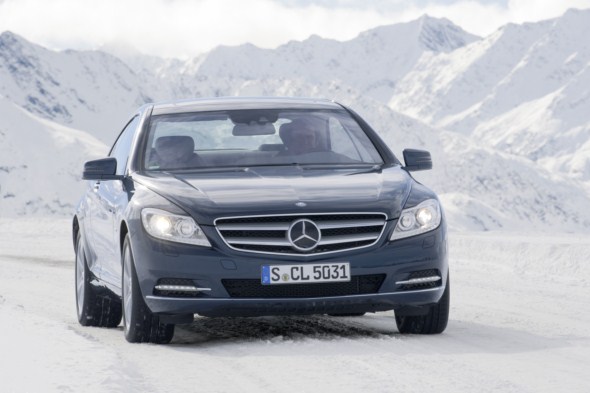
The key technical data for the CL 500 4MATIC BlueEFFICIENCY:
| Model | Cyl. | cc | kW/hp at rpm | Nm from rpm | 0-100 km/h (s) | Top speed km/h | l/100 km NEDC comb. | CO2 g/km |
| CL 500 4MATIC BE* | V8 | 4663 | 320/435 5250 | 700 1800 | 4.9 | 2501 | 9.9-10.1 | 237-242 |
* BE = BlueEFFICIENCY; 1 electronically governed
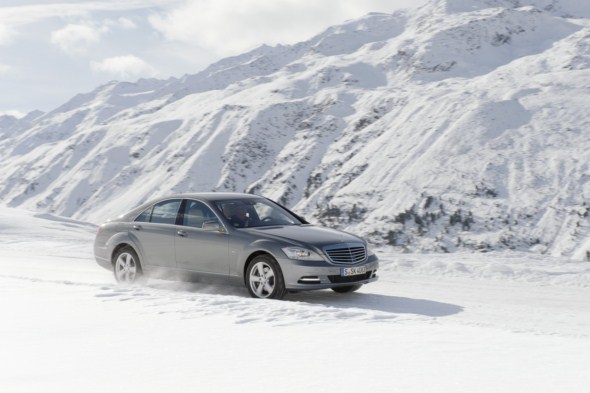
The key technical data for the S-Class 4MATIC models:
| Model | Cyl. | cc | kW/hp at rpm | Nm from rpm | 0-100 km/h (s) | Top speed km/h | l/100 km NEDC comb. | CO2 g/km |
| S 350 BlueTEC 4MATIC | V6 | 2987 | 190/258 3600 | 620 1600 | 7.1 | 2501 | 7.3-7.4 | 193-194 |
| S 350 4MATIC BE* | V6 | 3498 | 225/306 6500 | 370 3500 | 6.9 (7.1)2 | 2501 | 8.1-8.3 | 189-193 |
| S 500 4MATIC BE* | V8 | 4663 | 320/435 5250 | 700 1800 | 5.0 | 2501 | 9.8 (9.9)2 | 228-229 (230-231)2 |
* BE = BlueEFFICIENCY; BlueTEC = diesel model; 1 electronically governed; 2 figures in brackets apply to long-wheelbase variant
The Mercedes-Benz R-Class: spacious, prestigious and exceptionally
comfortable
An all-rounder in peak form: since June 2010, the overall appearance of the R-Class has benefited considerably from the completely restyled front section in particular, and borrows elements from the Mercedes-Benz saloons and SUV models. In addition to the fresh exterior, the inner virtues of the R-Class are also impressive. These include economy of space on a par with the latest MPVs, as well as the comfort, high-class appeal and prestige associated with classic Mercedes-Benz luxury saloons. At the same time, the latest generation offers the same level of interior diversity for which its predecessor was renowned, and also boasts the robustness and all-wheel drive properties of the Mercedes-Benz SUVs. It has certainly thrilled customers – year-on-year sales have doubled!
In addition to the sophisticated petrol engines adopted from the outgoing model, with their customary effortless power delivery and excellent drive comfort, the appeal of the R-Class is further enhanced by a choice of optimised diesel engines. The new R 350 CDI 4MATIC blends the high performance of a V8 model with the low fuel consumption of an economical V6. It burns just 8.5 litres of diesel* per 100 kilometres, thereby undercutting its predecessor by 0.8 litres – yet is able to offer significantly enhanced performance. Whereas previously, the output topped out at 165 kW (224 hp), the V6 diesel unit now delivers a highly impressive
195 kW (265 hp) as well as 620 Newton metres of torque. This powerpack endows the sportiest of all the diesel-engined R-Class models with superlative performance credentials. It sprints from 0 to 100 km/h in 7.6 seconds and reaches a top speed of 235 km/h. * Combined NEDC consumption
Mercedes-Benz offers one of the cleanest diesel models in the world with the R 350 BlueTEC 4MATIC. The V6 engine produces an output of 155 kW (211 hp) together with 540 Newton metres of torque. Compared with its predecessor, this model likewise manages to achieve lower fuel consumption and emissions combined with superior performance. Equipped with AdBlue® emission control, the compression-ignition engine consumes an average of 0.3 litres less, at 8.4 litres of diesel* per 100 kilometres, thereby giving off the same level of emissions as a comparable petrol engine. As a result, this model already meets the EU6 emission limits planned for 2014. The remaining petrol and diesel models in the R-Class range all meet the EU5 standard. * Combined NEDC consumption
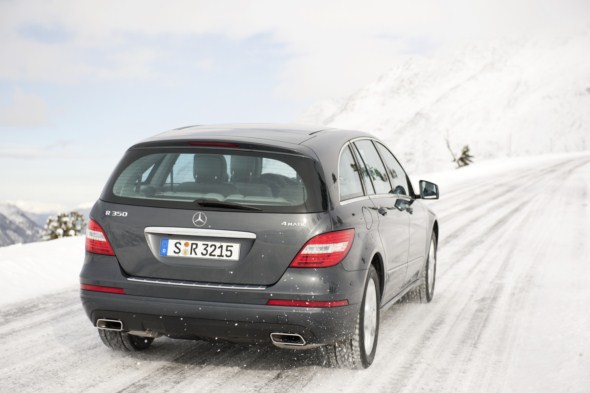
The key technical data for the new-generation R-Class:
| Model | Cyl. | cc | kW/hp at rpm | Nm from rpm | 0-100 km/h (s) | Top speed km/h | l/100 km NEDC comb. | CO2 g/km |
| R 350 CDI 4MATIC* | V6 | 2987 | 195/265 3800 | 620 1600 | 7.6 (7.7)2 | 235 (235)2 | 8.5 (8.5)2 | 223 (223)2 |
| R 350 BlueTEC 4MATIC1 | V6 | 2987 | 155/211 3400 | 540 1600 | 8.9 | 220 | 8.4- 8.5 | 222-223 |
| R 350 4MATIC | V6 | 3498 | 200/272 6000 | 350 2400 | 8.3 (8.4) | 230 (230) | 11.6-11.9 (11.7-11.9) | 271-279 (274-279) |
| R 500 4MATIC1 | V8 | 5461 | 285/388 6000 | 530 2800 | 6.3 | 2503 | 13.2-13.4 | 306-311 |
* CDI/BlueTEC = diesel models; 1 only available with long wheelbase; 2 figures in brackets apply to long-wheelbase variant; 3 electronically governed
The history of all-wheel drive models from Mercedes-Benz
Over 100 years of traction to the power of four
- Foundations of all-wheel drive technology laid in 1903
- Passenger cars: from the “Dernburg-Wagen” (1907) to the CLS 4MATIC
- Off-roaders: from the G1 to the G-Class and the ML, R, GL and GLK SUVs
- Commercial vehicles: Unimog, trucks and vans
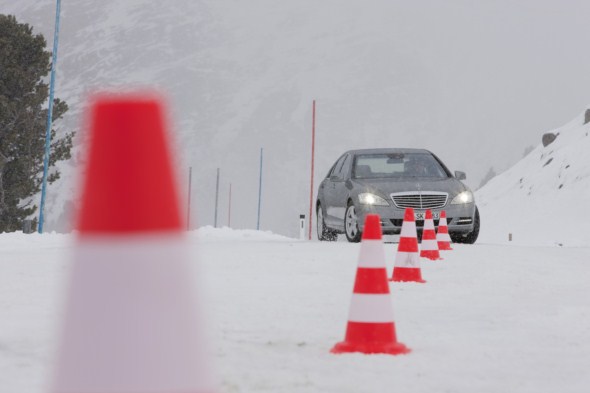
Paul Daimler, the son of the company’s founder, came up with the first designs featuring all-wheel drive as long ago as 1903. In 1907, the “Dernburg-Wagen”, as it was known, was produced for driving in Africa. Although built on the basis of a truck, it was designed as a passenger car, making it the forefather of today’s cars with 4MATIC drive.
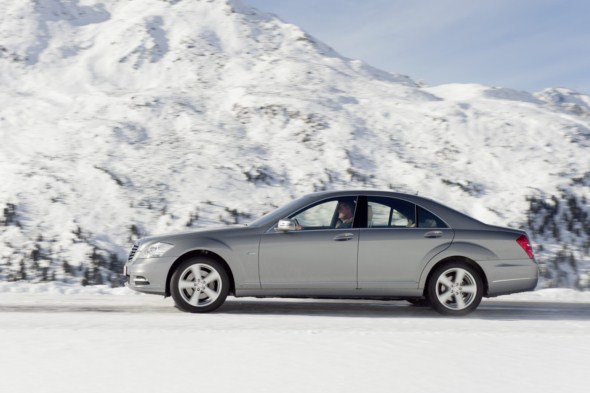
The first ever all-wheel drive passenger car from Mercedes was the W 124 E-Class model series, whose 4MATIC versions made their debut in 1985 at the IAA International Motor Show in Frankfurt.
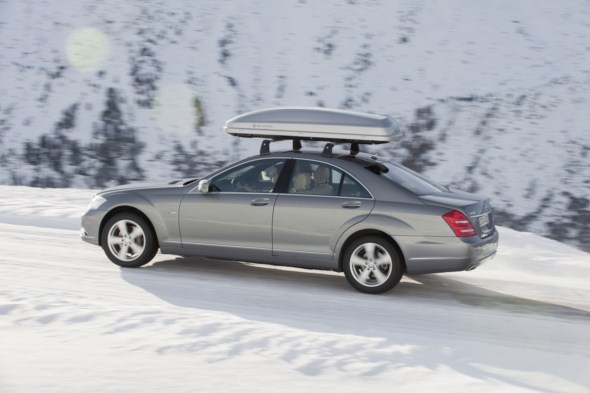
Today’s off-roaders and SUVs have a long ancestry too. Mercedes-Benz unveiled its G 5 model in October 1938 at the London Motor Show as a “colonial and hunting vehicle”. Alongside the G-Class, which has been powering through cross-country terrain since 1979, the G 5 is therefore the forerunner of today’s SUV models in the form of the M-, R-, GL-Class and the GLK.
Besides this, the company also has a tradition of building commercial vehicles with off-road capabilities – from the legendary Unimog to trucks to delivery vans such as the Vito and Sprinter.
The first all-wheel drive car for everyday use is built by the Daimler-Motoren-Gesellschaft (DMG) in 1907. The “Dernburg-Wagen”, as it is known, even features all-wheel steering. It is designed for the then Secretary of State Bernhard Dernburg, who was to drive many kilometres in it while on colonial service in Africa the following year. Engineer Paul Daimler, son of the company founder, uses a truck chassis from the Daimler-Motoren-Gesellschaft as the basis for the new vehicle, which has a price tag of 34,750 Marks.
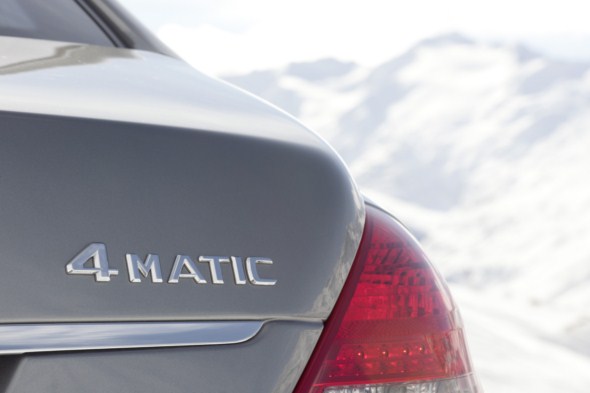
It is fitted with a touring car body including two seats on the chauffeur’s bench and a total of four seats in the rear. With a length of around 4.90 metres and a height of a good 2.70 metres including the roof structure, the majestic vehicle weighs around 3.6 tonnes when fully laden with all the special items specified by the Colonial Office, such as a particularly heavy-duty clutch, as well as petrol and coolant reserves for tropical conditions, replacement parts and tools.
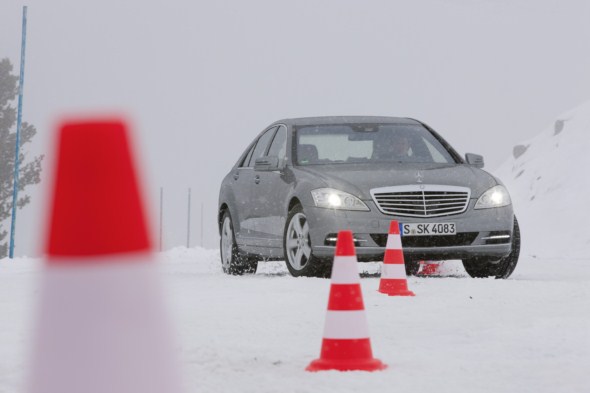
The four-cylinder engine generates a very respectable output of 26 kW (35 hp) at 800 rpm from a displacement of about 6.8 litres – allowing a maximum speed of around 40 km/h on level tarmac. Far more important for the vehicle however, in view of the special operating conditions, is the climbing ability made possible by the all-wheel drive: an impressive 25 percent.
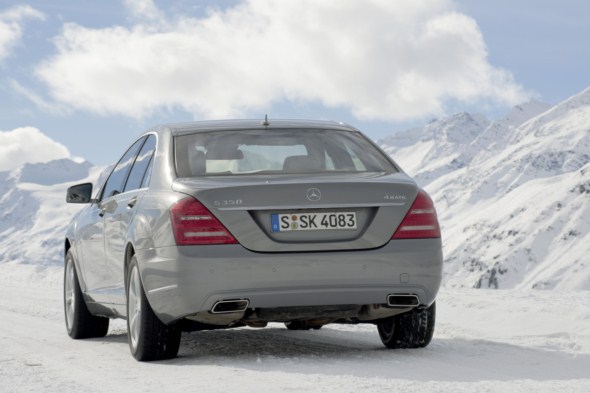
The vehicle features permanent all-wheel drive with the engine transmitting its power to the four wheels via a sophisticated mechanical system. A shaft connects it to the transmission with four forward gears and one reverse gear that is installed exactly in the middle. From there, propshafts transfer the torque to the front and rear axle differentials.
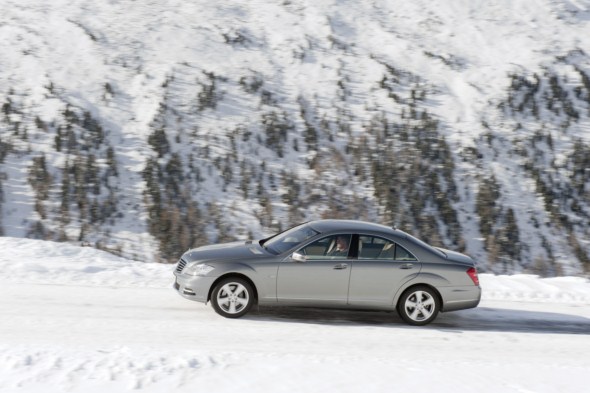
The design engineer Daimler takes special precautions to keep fine airborne sand out of the drive components. Because the solutions used limit the maximum steering angle to just 23 degrees, the vehicle is equipped with steerable wheels at the rear too in order to achieve a reasonable turning circle.
A highly prestigious vehicle for off-road terrain
1934 sees the introduction of the mighty, six-wheeled G 4 passenger vehicle (W 31 model series), which is built at the Untertürkheim plant. Heads of state and high-ranking military officers soon came to appreciate the 3.7-tonne vehicle as a highly prestigious vehicle with off-road prowess. Power is transferred to the two rigid rear axles by a propshaft, while two locking differentials ensure good off-road capabilities (climbing ability when fully laden: 43 percent). Counting all the engine variants, a total of 57 are made up until 1939.
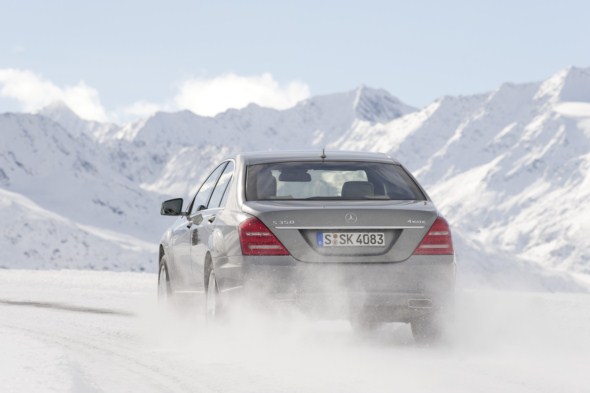
The first series (1934 to 1936) is powered by a model M 24 5.0-litre eight-cylinder engine developing 74 kW (100 hp) at 3400 rpm. For the second series (1937 to 1938) the engine is enlarged to a displacement of around 5.3 litres with an output of 85 kW (115 hp), increasing again to 5.4 litres and 81 kW (110 hp) in the third series.
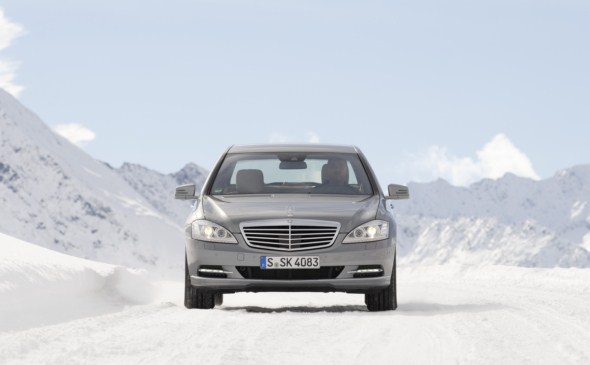
Although more would be feasible, the G 4 is only permitted to drive at a maximum speed of 67 km/h owing to its great weight and the limitations on tyre stability at the time. The G 4 has an immense thirst for fuel, with figures of 28 litres per 100 kilometres on the road and 38 litres off-road. So it is little wonder that some models are fitted with a 140-litre tank.
High-tech for passenger cars: Mercedes-Benz 4MATIC
In the mid-1980s, the time is right to introduce all-wheel drive in Mercedes-Benz passenger cars too. At the 1985 IAA International Motor Show in Frankfurt, the engineers present their new all-wheel drive concept to the general public under the name of 4MATIC. The new system also employs electronics to provide optimum drive power at all times in any driving situation.
The foundations for this technology were laid by the anti-lock braking system (ABS) in 1987. This provides the launch pad for the acceleration skid control system (ASR, series production launch 1981), which is designed to control the interplay of longitudinal forces between the tyres and the road surface not only during braking, but when accelerating too by acting on both the brakes and the engine torque. This is later followed by the automatic differential lock (ASD, 1985) and the Electronic Stability Program (ESP®, 1995).
A common feature of these systems is the way they measure wheel slip using advanced microelectronics and hydraulics, and limit it in order to improve a car’s longitudinal dynamics. 4MATIC is permanently active and distributes the drive power between the front and rear axles during normal driving on a surface with good traction.
4MATIC is premiered in the W 124 model series in 1987. The Electronic Traction System 4ETS, which performs the function of differential locks and ensures even better progress on poor surfaces, is added from the 210-series E-Class onward, starting in 1997. 4ETS is integrated into the Electronic Stability Program (ESP®), whose control functions are specifically adapted for all-wheel drive. If one or more wheels lose grip on a slippery surface, 4ETS automatically applies brief braking impulses to the individual spinning wheels while increasing drive torque to the wheels with good traction. This automatic braking intervention is able to simulate the effect of up to three differential locks.
By the time the new 210-series E-Class comes onto the market in 1995, the technology has advanced considerably. The new 4MATIC consists of a permanent all-wheel drive system with a single-stage transfer case providing a front-rear power split of 35:65. It is supported by the Electronic Traction System 4ETS. The new 4MATIC system makes its debut in February 1997 in the E 280,
followed in June by the E 320, with an estate version also available in both cases.
In January 2003, Mercedes-Benz presents the new 211-series E-Class at the North American International Auto Show in Detroit. From the autumn of that same year, 4MATIC all-wheel drive also becomes available for the E 240, E 320 and E 500 models, once again in both saloon and estate versions. A further distinguishing feature of the 4MATIC models compared to the rear-wheel-drive versions is that they are exclusively available with the five-speed automatic transmission. The E 280 CDI and E 320 CDI 4MATIC diesel models follow in July 2005. Combining 4MATIC permanent all-wheel drive with the up-to-date V6 CDI engines enables new standards to be achieved in terms of safety, traction, pulling power and fuel economy.
Traction at its most luxurious: the S-Class 4MATIC
For the 2003 model year, Mercedes-Benz embarks on an all-wheel drive initiative for its passenger cars, making a total of 32 models available with 4MATIC in five model series. As part of this initiative, 4MATIC is made available in the S-Class (W 220 series) during the second half of its production cycle for the S 350, S 430 and S 500 models – including the long-wheelbase versions.
Its successor, the W 221-series S-Class, celebrates its debut in September 2005, with all-wheel drive being launched exactly one year later at the Paris Motor Show in September 2006. For the first time ever, there is an S-Class with a diesel engine and all-wheel drive in the form of the S 320 CDI 4MATIC; it is joined by 4MATIC versions of the S 350, S 450 and S 500, once again with a choice of either short or long wheelbase.
From March 2008, Mercedes-Benz also starts to offer the CL-Class luxury coupé (C 216) with all-wheel drive in the CL 500 4MATIC model. At its heart is the 7G-TRONIC seven-speed automatic transmission, which had been specially developed for all-wheel drive models and has a transfer case with centre differential lock incorporated into it. It splits the drive torque between the front and rear axle in the ratio 45:55. The newly developed multi-plate clutch at the centre differential transmits the engine’s power to all four wheels with a basic locking effect of 50 Newton metres between the front and rear axle. This results in even better start-off characteristics and handling stability on slippery surfaces. At the same time, the all-wheel drive system is exceptionally efficient: the CL 500 4MATIC consumes no more fuel than the corresponding rear-wheel drive model.
The 203-series C-Class also becomes available with 4MATIC as part of the 2003 all-wheel drive initiative. There is a choice of the C 240 and C 320 six-cylinder models in either saloon or estate form.
In the summer following the Europe-wide market launch of the C-Class from the 204 model series in spring 2007, all-wheel drive becomes available in the six-cylinder C 280, C 350 and C 320 CDI models, and from the autumn in the C 320 CDI 4MATIC Estate too. The 4MATIC system had undergone a thorough overhaul: not only is the latest-generation all-wheel drive technology more efficient, it also weighs less and has a more compact design than the previous 4MATIC. These benefits pay dividends in terms of lower fuel consumption and even greater traction. The all-wheel drive C-Class models are also equipped with the modified 7G-TRONIC seven-speed automatic transmission as standard.
Finally, autumn 2009 sees the launch of what is now the fourth generation of the E-Class to feature 4MATIC. The E 350 CDI BlueEFFICIENCY and E 350 (both saloon and estate versions) as well as the E 500 saloon are the representatives of the 212 model series that are available with the permanent all-wheel drive system.
And now a very special model series is the latest to enjoy the benefits of enhanced traction: the new CLS four-door coupé will be available with 4MATIC for the first time from 2011, with a choice of either the CLS 350 CDI BlueEFFICIENCY or CLS 500 BlueEFFICIENCY.
Off-roaders: it all starts with the Mercedes-Benz G 5
In the 1930s, Mercedes-Benz designs a variety of all-wheel drive vehicles, mainly for use by the German armed forces, although the customer was to ultimately decide otherwise. These include the 160 HM model (W 133 II series) from 1935/36 as well as the 160 VL (1936, W 139). In 1935 the company also produces the 170 VG Kübelwagen (W 133 III series) with a selectable front-axle drive. This is followed in 1936 by the 170 VL (W 139) with permanent all-wheel drive as a precursor to the G 5, still equipped with a 1.7-litre engine. For greater manoeuvrability, this also features selectable four-wheel steering, which reduces the turning circle from eleven to seven metres. Roughly 100 units of these two models are delivered in total.
In technical terms, the Mercedes-Benz G 5 (W 152 series, 1937 to 1941) is the successor to the 170 VL, being also equipped with all-wheel drive and selectable all-wheel steering. Once again the military shows little interest, and in order to expose the G 5 to a wider public, the company presents it at the London Motor Show in October 1938 as a “colonial and hunting vehicle”. Three body versions are available ex factory: a military Kübelwagen body, a touring car with side
windows and tropical folding soft-top roof, as well as an all-purpose crew vehicle for the police, for instance. Power is provided by a four-cylinder engine with a displacement of 2.0 litres and an output of 33 kW (45 hp) at 3700 rpm. The all-wheel drive system features three differential locks. A rarity at the time, the transmission has five forward gears, although first gear with its reduction ratio of 7.22:1 is exclusively reserved for off-road operation. The handbrake acts on the propshaft, while the suspension is fully independent all-round. Maximum speed of the G 5 is 85 km/h, with a proviso in the operating manual not to exceed 30 km/h with the all-wheel steering activated.
Several of these vehicles are used by the German mountain rescue services, some of them until well after the end of the Second World War. Despite the wide range of variants and its technical perfection, the G 5 meets with little success: 378 are built in total.
Nonetheless this model may be seen as the forerunner of the privately-owned off-road vehicle, so popular nowadays. Nevertheless, it would be many years before Mercedes-Benz included all-wheel drive passenger cars in its model range again: 1979 marks the launch of the G-Model, which has since become an outstanding success story.
In a class of its own: the Mercedes-Benz G
The development of the Mercedes-Benz G-Model commences in 1972, when a cooperation agreement is signed between Daimler-Benz and Steyr-Daimler-Puch in Graz, Austria. The decision to start series production of the G-Class is taken in 1975. At the same time it is decided to construct a new plant in Graz, where the vehicle has been built mainly by hand throughout its many years of production.
In all there are four G-Class model series. The 460 (from 1979 onwards), 461 (1991) and 463 (1989) series are produced in Graz, while the 462 series is assembled from CKD kits in Thessalonica, Greece from 1991.
Contrary to the popular view, the G-Class was neither conceived as a military vehicle, nor as a passenger car: the designers initially had their eyes on the civilian commercial vehicle market. There is a change of direction during the concept phase, however, and the vehicle is designed instead for operation in extremely difficult terrain. The vehicle’s backbone is a box frame with enclosed side members and cross members, ensuring exceptional flexural and torsional strength. The frame supports robust rigid axles with large coil springs and long spring travel – a great advantage for off-road driving. With a climbing ability
of up to 80 percent, a maximum tilt angle of 54 percent, 21 centimetres of ground clearance and angles of approach and departure of 36 and 27 degrees respectively, the G-Class is equipped to negotiate the toughest off-road terrain with majestic ease. At the same time, the chassis also provides safe and comfortable handling on smooth tarmac.
Production of the G-Class commences in Graz on 1 February 1979. Daimler-Benz provides the entire drivetrain including engine, transmission, axles and steering, as well as the larger pressed components. Stamped and smaller pressed parts as well as the transfer case, meanwhile, are produced by Steyr-Daimler-Puch. All versions feature a manual four-speed transmission and intermediate gearing.
The all-wheel drive with additional off-road ratio is selectable, as are the 100% differential locks on both rigid axles. The sophisticated suspension with trailing arms and wishbones, coil springs and shock absorbers makes for
excellent handling both on and off the road. Power steering is only available for the 300 GD and 280 GE as standard.
Civilian customers are able to order the G as a station wagon with a short or long wheelbase, or as a cabriolet with a short wheelbase. They come with a choice of just five paint finishes: cream white, wheat yellow, colorado beige, carmine red and agave green. For the military there is also a long-wheelbase cabriolet with two or four doors. In November 1980 the range is extended by a closed box-body variant with either a short or long wheelbase.
The original intention to design the G as a commercial vehicle can be seen from the list of optional extras, which includes items such as a lockable glove compartment, power steering, halogen headlamps and a clock. Indeed, the two-spoke steering wheel and numerous switches had been taken straight from the Mercedes-Benz commercial vehicle range. It is only the price tag of a well-equipped G-Model that indicates the direction the G would one day take with almost visionary insight: it costs around as much as an S-Class.
The 460 series is phased out in 1991, while the plant in Graz prepares to change production over to the more up-to-date 461 series launched in 1992. This is aimed at all those customers who attach particular importance to the technical attributes of the G-Class, and for whom the interior needs to be suited to practical use rather than overly homely – the military, surveyors, foresters, landscape gardeners or adventure travellers, for instance. In contrast to the 463 model series with permanent all-wheel drive, the 461 features selectable all-wheel drive with differential locks at the rear axle; these are available as an optional extra at the front. Other standard features include a five-speed manual transmission and a 96-litre fuel tank.
The 461 series is available in three wheelbases and seven body variants. This offers an immense number of permutations, so vehicles can easily be configured for highly specific purposes. The 461 series is eventually discontinued in 2002.
The G-Class 463 model series
In early 1987, the creators of the G-model begin to think about designing a more upmarket model series. It is christened with the number 463 and makes its debut in 1989 at the IAA Motor Show in Frankfurt. The G-Class now comes under the aegis of the Mercedes-Benz Passenger Car Division. The move to the 463 model series is necessary as the civilian market has become very important in the meantime and is calling for an anti-lock braking system and airbags, for example, requiring an extensive redesign. Moreover, fewer and fewer civilian customers are smitten by the rustic charm of a simple hunting cabin on wheels – more comfort and luxury is needed. The new generation is designed along the lines of upper mid-range passenger cars, with appointments very similar to the Mercedes-Benz saloons. The dashboard design is adopted from the 124 model series, while fine wood trim and comfortable seats form part of the standard equipment. There is a choice of upholsteries, including leather, as well as various colours for the interior trim, allowing the passenger compartment to be given a colour-coordinated finish. Seating comfort in the rear is also improved. The 460 series continues to be built for customers who still prefer a rather plainer appearance.
The initially optional anti-lock braking system (ABS) makes a permanent all-wheel drive system necessary, with an inter-axle differential providing compensation between front and rear axles. Three differential locks operated by three switches in the centre of the dashboard are also included. Activating the centre switch automatically switches off the ABS, as the wheel brakes cannot be individually controlled in full through-drive mode.
Since 2001, the G-Class has also been equipped with the Electronic Stability Program (ESP®), 4ETS and Brake Assist, thereby offering a unique combination of highly effective traction and handling safety systems which improve both road safety and off-road capability even further.
Since the market launch of the G-Class, a total of 200,000 vehicles have been delivered to customers worldwide.
The Sport Utility Vehicle from Mercedes-Benz: the M-Class
In 1997, Mercedes-Benz enters a fledgling market with the launch of the M-Class (W 163 series). The Sport Utility Vehicle (SUV) is equipped with 4MATIC all-wheel drive throughout the range. The drivetrain is designed for permanent all-wheel drive from the outset. A transfer case with an integral centre differential distributes the drive torque to the front and rear axles on a 50:50 basis. As in the other 4MATIC models from Mercedes-Benz, differential locks are replaced by the 4ETS system in the M-Class. An anti-lock braking system is part of the standard specification; it is specially configured for off-road use and prevents the wheels from locking at speeds above 8 km/h, whatever the state of the ground. When the low-range gearbox is activated (reduction ratio of 2.64), a special programme for speeds up to 30 km/h shortens braking distances on loose surfaces.
The M-Class is manufactured in the new plant in Tuscaloosa, Alabama, and the USA and Canada are the first markets to benefit from the new arrival in the form of the ML 320. In March 1998, the first units are delivered to Europe, where the ML 230 is added to the range. This is followed in the same year by the ML 430 with an eight-cylinder petrol engine. In October 1998, the torque split between the front and rear axles is changed to 48:52 to improve cornering agility on asphalt roads.
The 100,000th M-Class leaves the production line in February 1999. In May, the plant in Graz is commissioned as the second production site – particularly for the ML 270 CDI that is extremely important for the European market – as the G-Class and the E-Class 4MATIC are already built there.
From autumn 2000, the vehicle is equipped with a new improved version of the all-wheel drive system for even greater off-road prowess. 4ETS is enhanced with new functions that offered particular advantages on steep uphill and downhill gradients, and an actively controlled brake booster is introduced, which builds up pressure extremely rapidly. This enables the system to brake spinning wheels even quicker than before. 4ETS meters these braking impulses according to the vehicle speed, wheel acceleration and accelerator position.
Production of the W 163 series ends in December 2004, after total sales of around 650,000 units.
In 2005, the mantle of the 163-series M-Class is passed on to its successor, the 164 series, which is unveiled in January at the North American International Auto Show in Detroit. Since 2001, DaimlerChrysler had already invested a total of 600 million US dollars in expanding the Tuscaloosa plant, doubling its production capacity from 80,000 to 160,000 vehicles per year.
This increase in capacity benefits not only the M-Class, but also the R-Class that comes onto the market in the same year.
The new M-Class is launched with the very latest technology, including three powerful new engines, the 7G-TRONIC seven-speed automatic transmission as standard, the further improved 4MATIC all-wheel drive system, AIRMATIC air suspension and (as an option) the anticipatory occupant protection system PRE-SAFE®.
Mercedes-Benz had further advanced the permanent all-wheel drive and 4ETS traction system, adding additional functions such as Downhill Speed Regulation, start-off assist and off-road ABS. There is now a choice of two all-wheel drive variants to meet the varying requirements of off-road drivers: in addition to the basic version, a new Off-Road Pro Engineering package is available as an option, which enables the M-Class to handle even the trickiest terrain. Its primary features include a two-speed transfer case with a low-range ratio, manually or automatically selectable differential locks (100 per cent) between the front and rear axle and on the rear axle, plus a modified version of the AIRMATIC air suspension system which has been specially tailored to off-road driving and which raises the ground clearance by 110 mm to as much as 291 millimetres and the vehicle’s fording depth to a maximum of 600 millimetres.
A new spatial concept on wheels: the Mercedes-Benz R-Class
New York in March 2005, where Mercedes-Benz stages a world premiere at the International Auto Show: the R-Class. Its vehicle concept blends all the advantages of familiar vehicle categories such as a sporty saloon, estate, MPV and SUV into a new and distinctive character. Dimensions, design and dynamism are its outstanding attributes. The R-Class is first launched on the North American market in autumn 2005, and becomes available in Europe from early 2006.
The R-Class is available in two sizes, with external lengths of 4922 and 5127 millimetres. This gives the new Mercedes-Benz model the dimensions of a luxury-class saloon, but with a considerably more spacious interior.
Standard equipment includes the 4MATIC all-wheel drive developed by Mercedes.
The second generation of the R-Class is launched in June 2010. The overall appearance benefits considerably from the completely restyled front section in particular, and borrows elements from the Mercedes-Benz saloons and SUV models. At the same time, the latest generation offers the same level of interior diversity for which its predecessor was renowned, and also boasts the robustness and all-wheel drive properties of the Mercedes-Benz SUVs as well as new, highly efficient engines.
A mighty off-roader: the GL-Class
The GL-Class celebrates its world debut at the North American International Auto Show in Detroit in January 2006, and its European debut at the Geneva Motor Show in February. As the first full-size SUV (Sport Utility Vehicle) from Mercedes-Benz, it is the highlight of the show. As a unique feature in the GL segment, this powerful and comfortable seven-seater is equipped with a self-supporting body. The extremely robust and spacious yet lightweight construction gives the new GL-Class a competitive edge in terms of ride comfort, dynamism and safety.
Standard specification includes 4MATIC permanent all-wheel drive. Together with the standard AIRMATIC air suspension, precise speed-sensitive power steering and Adaptive Damping System (ADS), which likewise comes as standard, this gives the majestic GL surprisingly impressive handling. All engine variants of the GL are paired with the 7G-TRONIC seven-speed automatic transmission as standard. Partly by virtue of its wide ratio spread, the 7G-TRONIC helps to reduce fuel consumption in just the same way as the lightweight construction and the good aerodynamics for a vehicle of these dimensions (Cd = 0.37).
BlueTEC and all-wheel drive
Three models from Mercedes-Benz have the distinction of becoming the world’s first diesel SUVs not only to comply with the particularly stringent American BIN5 emissions standards, but also to have the potential to meet the strict EU6 emissions standards, thereby fulfilling all currently valid emissions legislation: the R 320 BlueTEC, ML 320 BlueTEC and GL 320 BlueTEC. They make their debut in June 2008, initially on the American market.
Compact model with genuine character: the GLK
The GLK receives its world premiere at the Auto China show in April 2008. Boasting a body shape that is as practical as it is arrestingly succinct, the distinctive all-rounder was to give the market segment of compact SUVs new direction. It also harmonises what were previously seen as entirely contradictory attributes, with supreme driving dynamics and outstanding driving safety going hand in hand with exceptional ride comfort thanks to the AGILITY CONTROL suspension. Meanwhile the variable 4MATIC all-wheel drive system joins forces with the latest electronic control systems to deliver consummate performance on the road and well-balanced skills off it.



